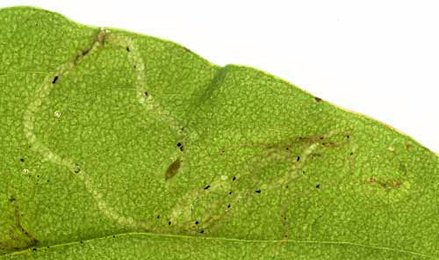|
||||||
|
Phytomyza
plantaginis Robineau-Desvoidy, 1851 Phytomyza
plantaginis Robineau-Desvoidy, 1851. Rev. Mag. Zool. (2)3: 404 |
||||||||||||||||||||||||||||||||||||||||||||||||||||||||||||||||||||||||||||||||||||||||||||||||||||||||||||||||||||||||||||||||||||||||||||||||||||||||||||||||||||||||||||||||
Leaf-miner: A narrow, whitish linear mine, normally in the leaf but more rarely also in the stem. Pupation at end of mine, with the anterior spiracles projecting through the epidermis (Spencer, 1972b: 84). Strikingly narrow corridor, upper-surface or lower-surface, often also alternating. Frass in comparatively large, very widely spaced grains. Generally the corridor is so narrow that the frass grains seems to lay in a single row. Pupation within the mine, sometimes in the petiole. The black anterior spiracles of the puparium penetrate the epidermis (Bladmineerders van Europa). The mine is also illustrated in British Leafminers.
Larva: The larvae of flies are leg-less maggots without a head capsule (see examples). They never have thoracic or abdominal legs. They do not have chewing mouthparts, although they do have a characteristic cephalo-pharyngeal skeleton (see examples), usually visible internally through the body wall. The larva is described by de Meijere (1926), Sasakawa (1961) and illustrated in Bladmineerders van Europa ; posterior spiracles each with about 12 bulbs. Puparium: The puparia of flies are formed within the hardened last larval skin or puparium and as a result sheaths enclosing head appendages, wings and legs are not visible externally (see examples). Whitish (Spencer, 1972b: 84). The puparium is illustrated in Bladmineerders van Europa. Hosts in Great Britain and Ireland:
Hosts elsewhere:
Time of year - mines: June-November. Time of year - adults: Currently unknown. Distribution in Great Britain and Ireland: Common and widespread throughout Britain (Spencer, 1972b: 84) including Inner Hebrides (Isle of Coll) (Bland, 1992), Rum (Bland, in Whiteley, 1994), Warwickshire (Keresley) (Robbins, 1991: 105); Anglesey, Cambridgeshire, Cardiganshire, Carmarthenshire, East Kent, Glamorgan, North Somerset, Nottinghamshire, Pembrokeshire, South-west Yorkshire, Stafford and Surrey (NBN Atlas) and the Channel Is. (Fauna Europaea). Also recorded in Ireland (Spencer, 1972b: 84). Distribution elsewhere: Cosmopolitan. Widespread in continental Europe, including Denmark, Finland, Norway, Sweden (Spencer, 1976: 469), Germany, Canary Islands (Mines in BMNH), The Netherlands (Bladmineerders van Europa), Belgium (Scheirs et al., 1994; van Frankenhuyzen, Houtman and Kabos, 1982), Germany (Spencer, 1976: 469), Azores, Belarus, Czech Republic, Estonia, European Turkey, French mainland, Hungary, Italian mainland, Latvia, Lithuania, Republic of Moldova, Poland, Romania, Slovakia, Spanish mainland, Switzerland and Yugoslavia (Fauna Europaea). Range extending east to the Kirghiz and Uzbek Republics of the [former] U.S.S.R. (Spencer, 1976: 469). Also recorded in Japan, Australia, Canada, the U.S.A. (Spencer, 1976: 469) and New Zealand, where it has probably been introduced and appears to be parthenogenetic (Spencer, 1990: 212). NBN Atlas links to known host species:
British and Irish Parasitoids in Britain and elsewhere:
|
| Last updated 10-Jul-2019 Brian Pitkin | ||

